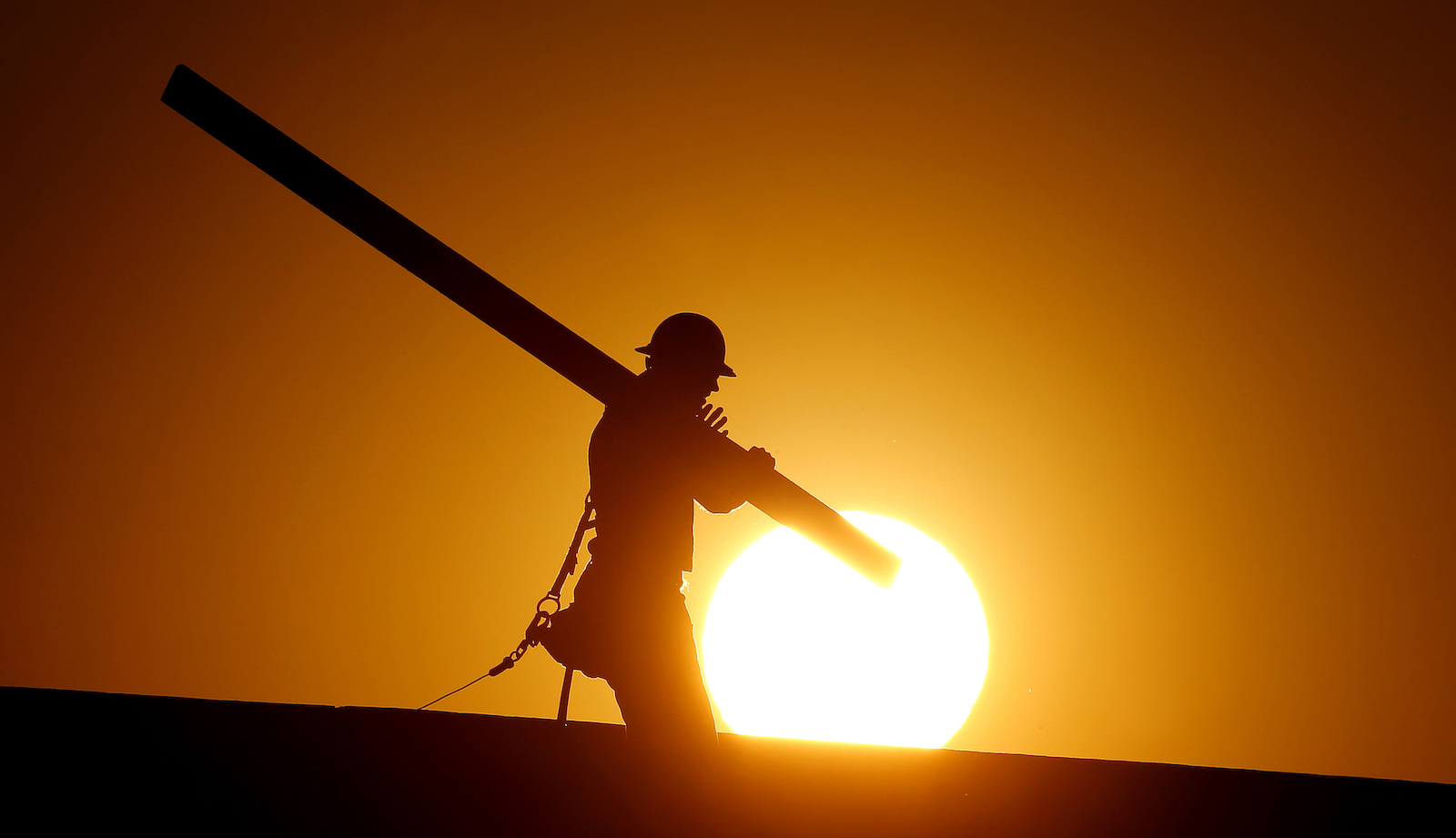This investigation was conducted by Columbia Journalism Investigations and the Center for Public Integrity and copublished in partnership with The Guardian. It was republished here as part of Covering Climate Now.
PHOENIX — Charlie Rhodes lived alone on a tree-sparse street with sunburned lawns just outside this Arizona city. At 61, the Army veteran’s main connection to the world was Facebook; often, he posted several times a day. But as a heat wave blanketed the region in June 2016 — raising temperatures among the highest ever recorded — his posts stopped. Three weeks later, a pile of unopened mail outside his door prompted a call to police.
When officers arrived, they were overcome by the odor of rotting garbage, worsened by the still-searing heat. Inside the home, they found the air conditioner broken and its thermometer reading 99 degrees. Rhodes lay dead in the bedroom, his body decomposing. The cause, his autopsy shows: “complications of environmental heat exposure.”
Yearly heat-related deaths have more than doubled in Arizona in the last decade to 283. Across the country, heat caused at least 10,000 deaths between 1999 and 2016 — more than hurricanes, tornadoes, or floods in most years.
Scientists link the warming planet to a rise in dangerous heat in the United States, as well as the spread of infectious diseases and other health conditions. Federal research predicts heat stroke and similar illnesses will claim tens of thousands of American lives each year by the end of the century. Already, higher temperatures pose lethal risks: The top five warmest years nationwide have all occurred since 2006. In the last six decades, the number of annual heat waves in 50 U.S. cities has, on average, tripled. In contrast to a viral pandemic, like the one caused by the novel coronavirus, this is a quiet, insidious threat with no end point.
The U.S. Centers for Disease Control and Prevention is charged with helping cities and states adapt to threats like extreme heat. Its climate program, created more than 10 years ago, is the federal government’s only sustained effort to bolster state and local health departments’ fight against global warming. But the program has been hampered by a decade of underfunding, limited expertise and political resistance, Columbia Journalism Investigations and the Center for Public Integrity found.
Interviews with more than 100 people and a review of hundreds of pages of government records show the Obama administration, while pushing measures to combat climate change, missed opportunities to expand the program. Under President Donald Trump, officials have tried to eliminate it. The tepid federal response has left state and local health workers ill-equipped to act, exposing communities to underappreciated threats that will only get worse. Already, the World Health Organization believes, the changing climate’s wide-ranging impacts contribute to at least 150,000 deaths around the globe every year.
Most local health departments, chronically underfunded and understaffed, don’t have the resources to prepare for climate-related hazards, surveys show. Less than half of state health departments have plans to adapt to these impacts.
The CDC created its climate program to fill that gap. Its primary grant — called the Climate-Ready States and Cities Initiative — funds and advises 18 health departments. The program commits each to a multi-step plan to identify their communities’ most pressing climate-related risks, then develop strategies to lessen them.
Arizona’s health department receives around $200,000 a year to fund its climate team. But for a state with seven million people — including a growing number of isolated, older residents like Rhodes — experts say it’s not enough money to pay for research and, most importantly, action.
Health departments can protect people from intensifying heat through awareness campaigns. They can remind residents to visit secluded neighbors on hot days. They can work with police and medical providers to reach out to those in need.
Arizona’s climate team proposed taking these very steps in a 2017 report for municipalities that came too late for Rhodes, a once-gregarious jokester who cut himself off from family and friends after the loss of his job and father. Rhodes devised a method to handle the heat: He covered his windows with aluminum foil and ran the air conditioner in his bedroom. But as the temperature hit 120 degrees near his home, no one checked on him.
Matthew Roach, who manages the Arizona health department’s climate program, touted its heat awareness campaign and other nationally recognized work to combat the dangers of increasingly hotter days. He acknowledged, though, that funding and staff turnover have impeded their efforts.
Asked what the program has done to prevent people like Rhodes from dying of heat, department spokesperson Holly Poynter noted that its advisories on the hottest days include a sentence encouraging people to check on at-risk friends, family and neighbors twice a day. “Heat-related deaths are preventable,” she said, “and continued work is needed due to increasing vulnerable populations within the state.”
The CDC defended its efforts on climate change, saying its program has assisted health departments successfully for years. “We’re proud of the work that our program is doing,” said Patrick Breysse, who heads the agency’s environmental health center and oversees its climate activities. “We’re excited about the leadership role we play.”
Some CDC-aided health departments lead the nation in heat illness prevention. San Francisco’s climate program helped devise heat emergency response plans and mapped vulnerable city neighborhoods. Now, officials use these maps to encourage neighbors to check on each other. Climate programs elsewhere helped change the threshold for heat advisories from 100 to 95 degrees after finding residents get sick at lower temperatures.
Yet many departments funded by the CDC are struggling to fulfill the program’s mission, according to government and academic reports and interviews with state and local health workers.
In North Carolina, program employees asked their CDC counterparts for guidance and expertise to identify the state’s climate health threats. Records show the agency failed to provide the assistance it promised early on. After nearly a decade of research, health workers only recently began reaching out to the most vulnerable residents.
In Florida, heat-related hospitalizations are on the rise. But health officials there barred the state climate team from publicly acknowledging global warming’s link to heat. Then, with the CDC’s imprimatur, they evicted the program from the health department.
Kristie Ebi, a climate and health expert at the University of Washington, has studied public health preparedness for climate change in the U.S. To protect the public, she said, the CDC program needs more resources and political backing. Her home state’s health department applied for the CDC’s climate grant in 2012, to no avail. Only recently has it received two “mini grants” totaling $45,000 — 18 percent of what it initially sought.
Most of the country’s state health departments — let alone its 3,000 local health agencies — get no such funding at all. They’re on their own to figure out what to do and how to pay for it.
“This is not an effective public health response,” Ebi said. “We need to get out in front of these issues. We need a federal response.”
A late start
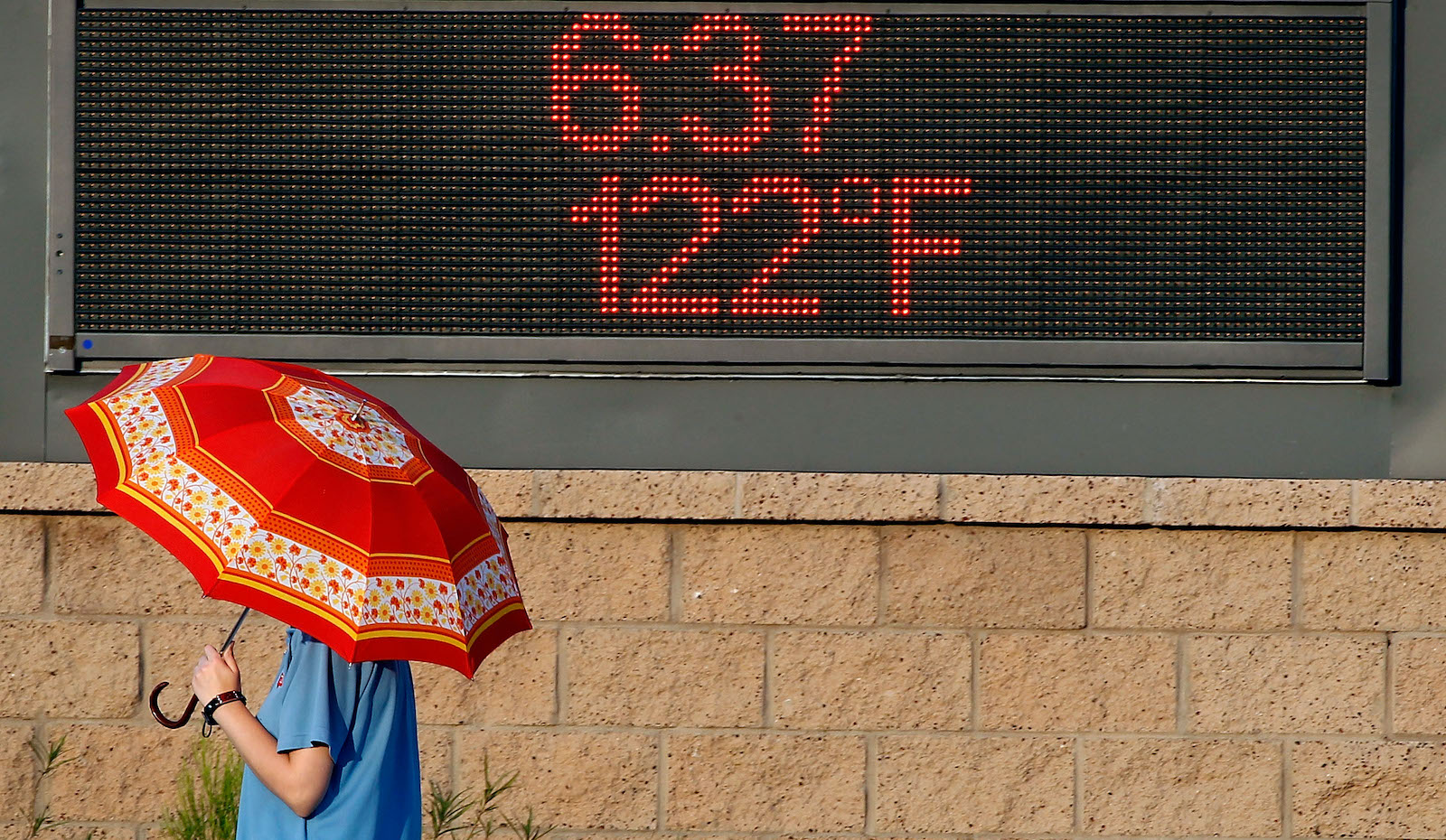
Ralph Freso / Getty Images
Federal officials have known for decades that climate change poses a public health crisis. In 1989, the U.S. Environmental Protection Agency issued a 100-page report on how global warming could affect human health. It urged public health agencies to fund research on extreme heat and provide health departments with “trained professionals.” By 2000, the U.S. released its first recurring assessment of the changing climate’s impacts. Again, it called for “investments in advancing the public health infrastructure.”
Five years later, Dr. Howard Frumkin, a veteran epidemiologist hired to run CDC’s environmental health center, brought the nation’s leading public health agency into the battle against climate change. “We knew that the climate was warming,” said Frumkin, who viewed the CDC as “past the point where we needed to be stepping up.”
At the time, there wasn’t a model for adapting public health to something as complex as climate change. The CDC designed programs to control specific risks, like AIDS or heart disease. The climate amplifies many threats at once. The agency was also created to respond after a crisis had happened, but climate change requires health officials to prepare for future events.
To devise a proactive approach, Frumkin tapped discretionary funds and two scientists — including a medical anthropologist, George Luber. They worked with national climate data to make large-scale analyses: showing how the country was warming, for instance, or that Lyme disease was creeping north as temperature changes made more places hospitable for ticks carrying it.
In 2009 — then the second-hottest year on record — Frumkin seized an opportunity to expand the CDC’s climate efforts. That February, he testified before a congressional committee about challenges brought by global warming. Health departments, he said, require climate and health training and data to plan for impacts. “CDC has in place many of the building blocks,” he told the committee, but it needed to assemble them into a serious effort.
A month later, a Democrat-led Congress gave the CDC $7.5 million for its climate program, to be renewed yearly with congressional approval. The new initiative seeded climate and health activities in 10 health departments. Frumkin hoped it would eventually expand to all 50 states.
Shortly after Congress funded the program, Dr. Thomas Frieden, then the newly-appointed CDC director, introduced his “winnable battles” — seven health initiatives that his agency prioritized. Climate was not among them. Most of those programs — nutrition, food safety — received an annual $50 million to $700 million by the end of his eight-year tenure. The climate program, by contrast, never exceeded $10 million. In 2013, the CDC recommended reducing that budget.
Christopher Portier, who succeeded Frumkin as environmental health chief from 2010 to 2013, remembers facing pressure from Frieden to limit climate funding. “He was an obstacle to environmental health as a general rule,” said Portier, who thinks the climate program requires at least $100 million a year, or $2 million per state. With its much more restricted funding, the program couldn’t hire more than a dozen full-time employees to concentrate on what the United Nations calls “the defining crisis of our time” and the WHO fears could “undermine decades of progress in global health.”
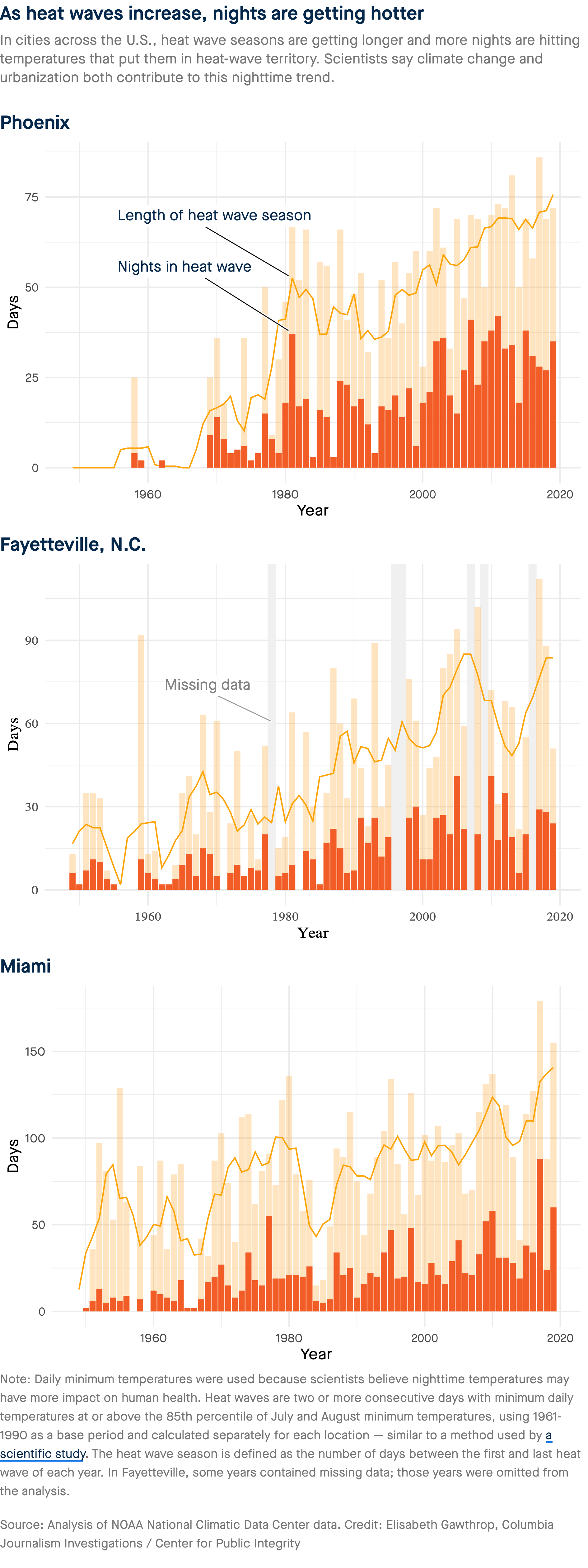
Frieden said he had little influence over funding decisions because Congress approves the budget. But he admits he undertook a “multi-year effort” to raise spending for other initiatives.
As the CDC’s director, he rarely used his bully pulpit to address threats posed by the warming planet. During a 20-minute keynote speech at a national environmental health conference, he discussed the topic for 13 seconds. Luber, who attended the event, recalls being shocked that Frieden spent more time on “the three Rs” — restaurants, rats and radiation.
Frieden, for his part, disputes claims that he did not prioritize climate change and insists he cares about the issue, pointing to the CDC’s work combating dangerous particulate matter produced by cars and coal plants. “It will have major public health consequences,” he said of climate change. “But there’s only a certain amount that public health programs can do.”
Many experts, including the American Public Health Association, which has lobbied to expand the CDC’s climate program, say otherwise. In 2015, the Government Accountability Office released a report criticizing the CDC for failing to provide leadership on global warming. The congressional watchdog called for a “commitment to communicating about the risks that climate change poses to public health.”
The CDC’s lackluster response contrasted with President Barack Obama’s public overtures and policy initiatives on climate. Former senior White House officials — including those who helped implement climate policies — admit the administration didn’t apply enough pressure on the CDC to act.
In December 2015, Republicans in Congress rejected a proposal to boost spending on the CDC program to $18 million. The increase would have more than doubled its size.
Obama advisers pushed for that, insiders said. It was the last time the White House would ask Congress to expand the program.
‘Not very much money’
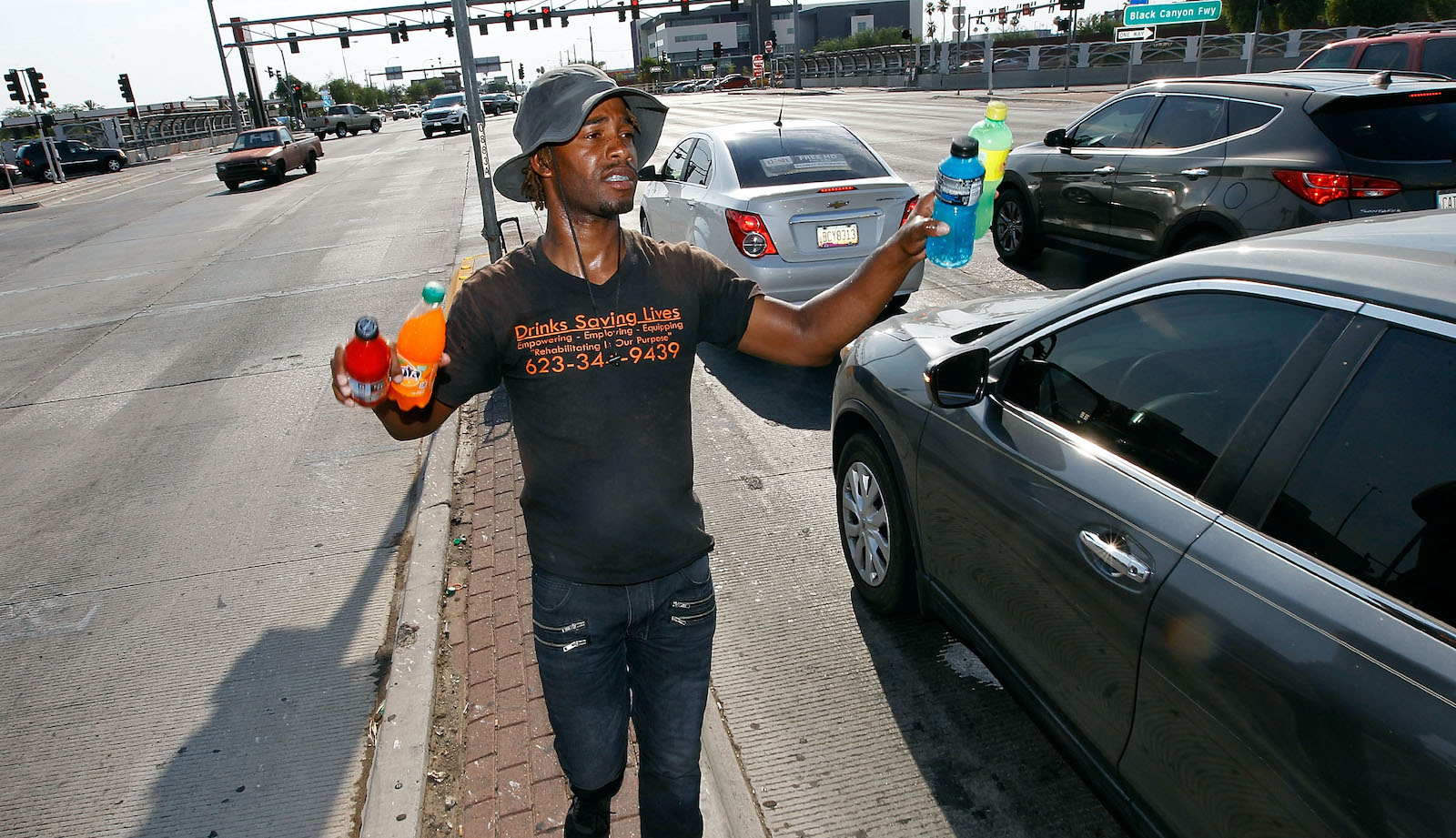
Ralph Freso / Getty Images
For CDC-aided health departments, the infusion of federal dollars brought an opportunity, often for the first time, to focus on the climate crisis. The money allows departments to hire a full-time employee or two and covers some programmatic costs. But at least half those agencies say a lack of funds has stunted their climate-related public health work, records and interviews show. A 2018 survey pegged low funding as the primary barrier to implementing CDC’s guidelines.
“It’s not very much money to do what we’re trying to do,” said Emily York of the Oregon program.
Limited funding presented obstacles from the start for Arizona’s health department, a CDC grant recipient since 2010. Records show even basic climate activities were hampered. In 2011, the program developed heat awareness toolkits for schools containing an educational DVD, heat index chart and more. But it had only enough money to burn DVDs and print materials for about one of every six school districts.
Health officials then undertook the complicated — and costly — task of quantifying local climate risks. In 2013, they planned to spend $40,000 on such work by university researchers. But after the CDC reduced their grant, Arizona officials first delayed the outside help and then shrank the funding amount.
Nalini Chhetri, an Arizona State University researcher, remembers delivering the health department more than what she and her team were paid for. They bought supercomputer capabilities to squeeze local temperature insights out of global data. She said she was never reimbursed for some expenses. “It was very little money for a lot of work,” Chhetri said. “We did it in the spirit of science.”
The summer of 2016 — when Charlie Rhodes died — showed there was no time to lose in the push to understand and stem heat death. The previous eight years, the number of heat-related fatalities in Arizona had averaged 145. That jumped to 219 in 2016, and 264 the year after. A report produced by Maricopa County — where the largest number of the state’s heat deaths have occurred — found that men, Native Americans and people 75 and older were most at risk.
Gene Moore, 82, fit all three categories. A Quechan Tribe member, he spent much of his life on its reservation, near Yuma, Arizona, before moving near Phoenix in 2010 to live with his son. Over the years, Moore’s health declined, but he remained mobile and enjoyed talking on the phone with friends, according to his son, Ivan.
In June 2017 — several weeks after Ivan had his home air conditioner repaired — he took his family camping in the mountains. Moore stayed behind. The day Ivan left, the temperature hit 118 degrees. Phoenix went 11 days at or above 110, one of only five such stretches on record. Four happened in the last three decades.
A week later, Ivan’s brother called to say Moore had stopped answering his phone. Ivan dialed the police. They found Moore dead on his bedroom floor, his window open. The air conditioner had broken again, and the temperature inside topped 105 degrees. Moore’s autopsy shows cardiovascular disease caused his death, while heat played a significant contributing factor.
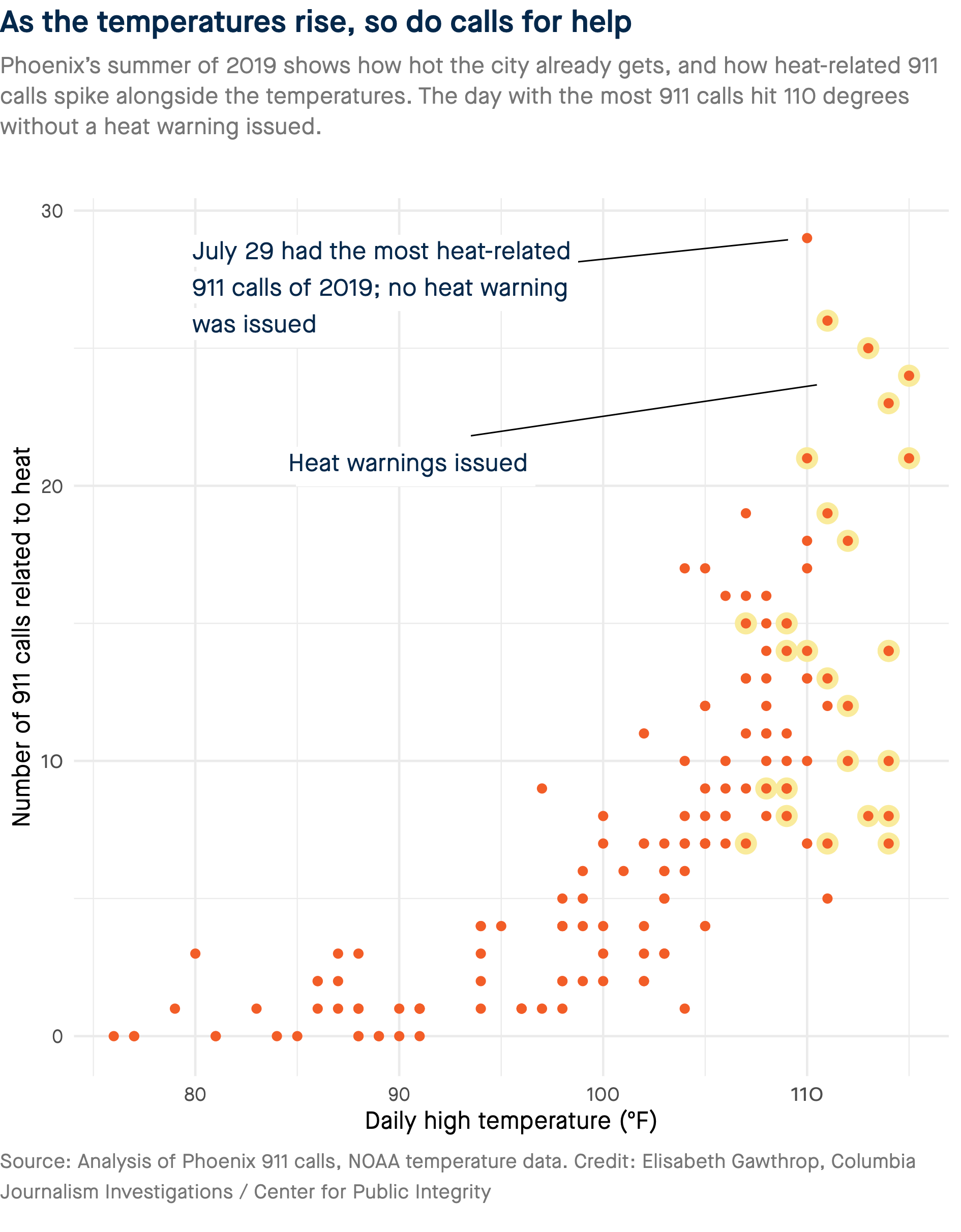
Arizona health officials still don’t know why more residents like Moore are dying or how best to protect them. Temperatures are rising in the state, but the hottest summers don’t always match the highest death tolls.
ASU researcher David Hondula, who works with the state’s climate team, contributed to a study ruling out temperature as the only reason. It found other factors such as homelessness and substance abuse may play a role. An analysis conducted for Columbia Journalism Investigations and the Center for Public Integrity does suggest an uptick in Arizona’s climate-related heat deaths. But, Hondula said, the state’s climate program doesn’t have money to keep studying the problem.
“If additional funding existed, we could really dive in to answer this question,” Hondula said. Instead, the limited CDC money — budgeted before the spike in deaths — supports awareness campaigns in poorer areas like Yuma County. It gets so hot there that, in August 2019, two students ended up in the hospital after a prank fire alarm forced them outside in 115-degree heat.
Many Arizona cities offer cooling centers — air-conditioned libraries, churches and other shelters — for residents to escape the heat. Moore and Rhodes both had access to a vehicle. Cooling centers were nearby. Health workers are now surveying residents who visit cooling centers, but say it takes money to determine why so many others don’t.
Moore’s son, who grew up hearing about heat death victims on the radio, blames himself for what happened to his father. “I should have had someone check on him sooner,” Ivan said, even though less than 36 hours had passed between Moore’s last email to his family and when police found him. “He had quite a few years left on him.”
Falling short as heat kills

Al Seib / Los Angeles Times / Getty Images
Health departments navigating the CDC funding shortage grapple with other resource problems, too. When the climate program launched, local health workers had little experience with the science involved. To bridge this divide, the agency agreed to advise grant recipients “above and beyond routine grant monitoring,” tapping the CDC’s expertise to train local staff.
But health departments’ current and former program managers say the CDC falls short on its obligations and has been slow to provide support.
In North Carolina, the program has helped enable what health department spokesperson Kelly Haight Connor described in an email as “the substantial growth in climate and health adaptation” there. Even so, documents show the state’s climate team ran into roadblocks almost as soon as it tried to evaluate the state’s preparedness for climate change. In 2011, a year into the effort, program managers asked CDC officers for guidance on “how to collaborate with climatologists successfully” and create heat warnings. They also requested access to crucial software licenses that would help identify communities endangered by climate-driven hazards.
Haight Connor said the CDC later delivered. But the team was still seeking the agency’s assistance — on planning outreach, on policy actions — when, in 2015, it completed an analysis showing heat-related mortality would increase over the coming decade. According to federal data, 220 North Carolinians have died from heat exposure over the past 20 years. State records show annual emergency room visits from heat-related illnesses have hovered around 4,000 from 2010 to 2018.
Guided by its analysis, the program focused on the state’s rural southeastern Sandhills region, where many residents living in poverty and working outdoors are at greater risk for heat illness. Program staff held meetings with county officials, surveyed existing prevention efforts and tested new outreach models. They planned for a heat alert system, paired with an education program that would target vulnerable workers, among others.
On June 22, 2015, Sherion Winfrey, 63, just returned to work after vacation and had nine days before she was due to retire. For nearly 40 years, she worked at the same oil- and air-filter factory in Fayetteville, a city in the Sandhills. She’d learned to pack frozen water bottles in a cooler to keep herself refreshed on the hot assembly line. But that day, as the temperature outside hit 96 degrees, she collapsed during her shift. Rushed to a hospital, Winfrey died early that same afternoon.
A state inspection of the factory the next day found that heat from the industrial ovens and the metal walls and roof of the unairconditioned production line raised the indoor heat index — a combined measure of temperature and humidity — to over 106 degrees and into the Occupational Safety and Health department’s “Danger” heat classification. The inspector recommended the factory allow employees time to acclimate to the heat after an absence. But the investigation into Winfrey’s death ended after a medical examiner found that Winfrey suffered “a fatal pulmonary embolism and did not die from exposure to extreme temperatures.” Recent research suggests this type of blood clotting may be brought on by daily temperature swings.
Danny Muhammad, Winfrey’s son, has no doubt heat contributed to her death. Winfrey complained to family about the factory’s stifling environment. “The heat index was out of this world that day,” Muhammad said. It was the ninth consecutive day that temperatures had reached at least 94 degrees — seven degrees hotter than the June average. Winfrey’s family filed a wrongful death lawsuit in 2017 against the factory, citing extreme indoor temperatures as the cause of her death, but the case was later dismissed. A spokesperson for the factory declined to comment.
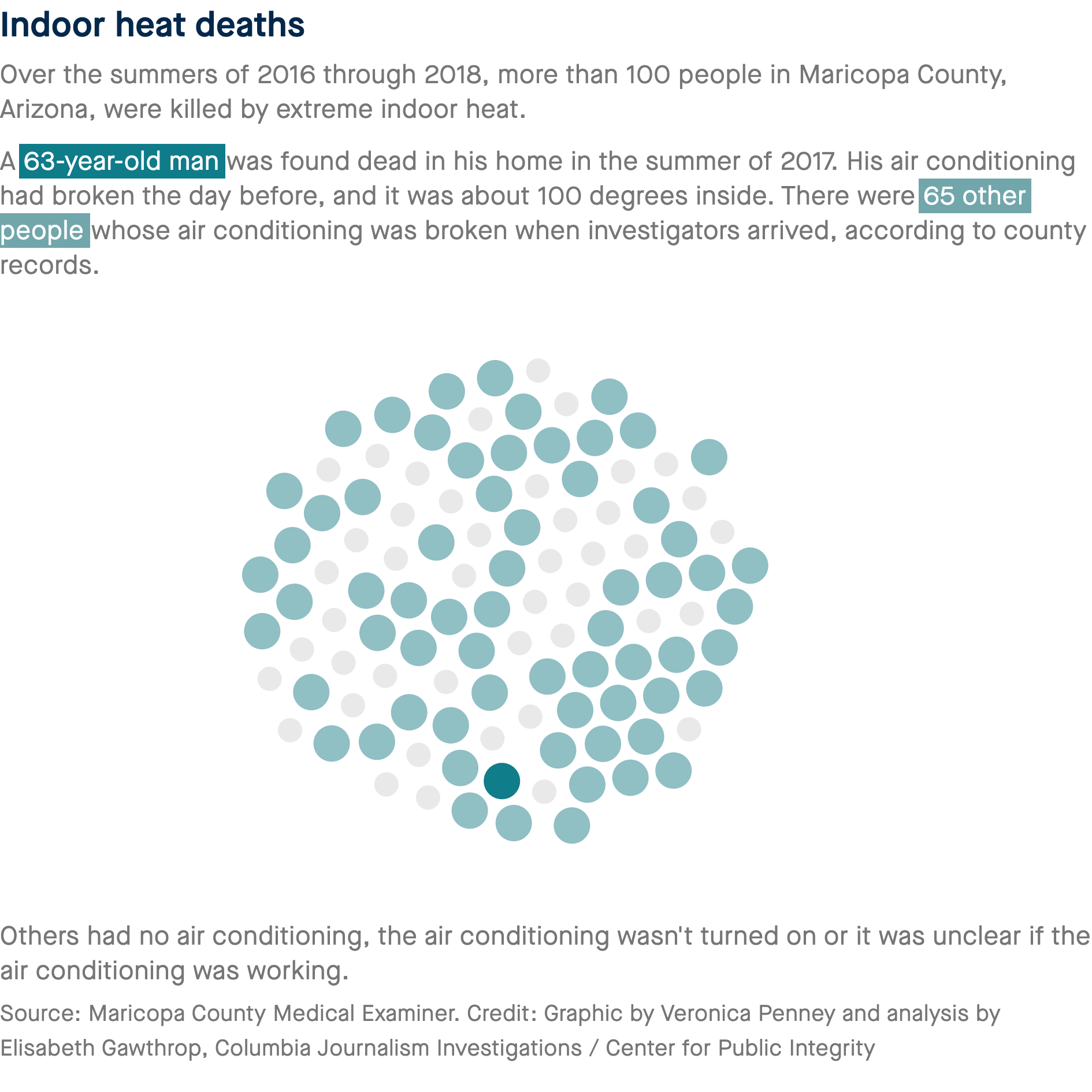
It took another three years after Winfrey’s death for North Carolina’s heat education efforts to begin in four Sandhills counties — and not where she had lived. Among them is Scotland County, a 50-minute drive from the factory where Winfrey worked. For years, county health educator Kathie Cox has spent summers alerting residents to the dangers of heat. Now, she passes out climate materials such as fans describing heat illness symptoms and water bottles detailing electrolyte-rich fruit water recipes.
Often, Cox speaks about her own experience with heat: On a hot summer day in 2018, feeling faint and seeing spots, she became sick from heat exhaustion while mowing her lawn. Her county poses outreach challenges: competing health demands; 1 in 6 residents reading at an elementary school level; a share of people who don’t think the world is warming.
North Carolina’s climate team — much like those in other grantee states — struggled to communicate with residents about climate change. Records show some states asked CDC for years to give them guidance. Only after the GAO issued its critical report did the CDC, in 2017, release a formal communications toolkit.
“I can’t in good conscience hold them accountable for being deficient,” one former CDC climate staffer said, referring to the grantees. “We gave them nothing.”
‘Incredibly detrimental’

Ralph Freso / Getty Images
The charged politics of climate change have only compounded health departments’ problems. Arizona researchers have seen mentions of “climate change” scrubbed from key reports. In Wisconsin and Maine, health workers say they have struggled without state leaders’ support. The CDC knew about such challenges for at least eight departments, records and interviews show.
Florida is an extreme case of political pushback. There, health workers have described a repressive environment that, according to a survey of CDC-funded departments, was “incredibly detrimental and an ongoing challenge.”
In 2013, the Florida health department interviewed Meredith Jagger, an environmental and public health specialist, to run its climate program. Jagger said she knew the state’s then-governor, Republican Rick Scott, doubted that climate change was real. At the interview, she remembers asking if his views could affect the program and being told she would have no problem if she was careful about language. Florida’s CDC grant application, for example, used the phrase “alteration of weather patterns.”
Jagger took the job, yet soon faced resistance. The CDC grant requires recipients to communicate their work to the public. Typically, Jagger received approval to speak to scientists and academics — not residents. Even then, she and other staffers said, the program’s presentations couldn’t contain references to climate change. Its reports relied on technical jargon intended to limit public awareness, Jagger said.
In 2015, after a series of news reports that the Scott administration had banned state employees from using the term “climate change,” Jagger said her superiors became more controlling. Jane Horton, a CDC climate program manager, flew to Tallahassee for a visit and remembers being pulled into an office with Jagger and two Florida health officials. The officials told her the CDC had to change the grant’s focus to extreme weather. They wanted to remove the word “climate” from its name.
According to Jagger’s notes from that meeting, Dr. Anna Marie Likos, then Florida’s chief epidemiologist, explained, “If someone Googles ‘climate change,’ we don’t want our name to come up.’” Likos couldn’t be reached through multiple phone calls, emails and letters requesting comment.
Jagger later learned the department would end its climate program and move the grant to Florida State University. She quit in protest. “My scientific integrity was compromised,” she said.
Now, located at that university, the program has no policymaking power. It funds public health projects in three of 67 counties. At the CDC’s suggestion, current staff shelved the work launched by Jagger’s team, including on extreme heat.
All the while, Florida’s temperatures keep rising. Over the last 40 years, the statewide average temperature increased about three degrees. Experts say a heat index above 90 is unsafe for strenuous outdoor activity, and now, one study shows, Florida crosses that threshold about 125 days a year.
One place identified as vulnerable by Jagger’s team is Lee County, where annual heat-related hospital visit rates have more than doubled in the past 15 years to eight out of 100,000 people. Under the CDC’s guidelines, Jagger’s team would have taken steps to raise awareness about the dangerous heat statewide. But in Lee — not among the three counties the program ultimately focused on — that never happened.
In June 2017, a year after the health department dismantled Jagger’s climate team, Zach Martin-Polsenberg kicked off summer football training. At 16, he was a junior at a high school in Lee’s county seat, Fort Myers.
On June 29, Zach’s mother, Laurie Giordano, dropped him off for practice around 7 a.m. Three hours later, as the heat index climbed to 96 degrees, she returned only to be rushed to the field. Zach had collapsed after running sprints, and his coaches believed he was dehydrated. He arrived at the hospital unresponsive, his internal temperature 107 degrees. Eleven days later, his death certificate shows, he died from complications of heat stroke.
“He was gentle, you know, deep in his soul,” said Giordano, whose primary worry about football was that her son would suffer from a head injury, not the heat.
After Zach’s death, she started a foundation so more schools are prepared for deadly temperatures with tools like athlete cooling tubs. A bill named for Zach that would require heat illness training for coaches is now awaiting the governor’s signature. Local health officials, she said, have been slow to act.
“They’re not sure it’s their job to do anything,” Giordano said.
In Miami-Dade, Florida’s most populous county, residents echo such sentiments. There, they experience an average of 154 days a year with a heat index above 90 degrees — estimated to rise to 181 by mid-century.
In November 2018 — on just such a day — José Delgado Soto, then 69, was cutting sweet potato vines on a local farm when he fainted. At the hospital, doctors found his body had overheated, damaging his kidneys. Today, his pain remains so intense that he can no longer work more than a few hours at once.
When he labors in the heat, Delgado Soto said, “it feels like my skin will come off.”
The Florida health department declined an interview request for this story because, a spokesperson wrote in an email, “the department does not have a dedicated heat-illness expert.” Lee County’s health department said it sees no need for heat awareness campaigns or policy actions in its communities.
“If you find a need,” said its spokesperson, Tammy Yzaguirre, “let us know.”
Under the radar
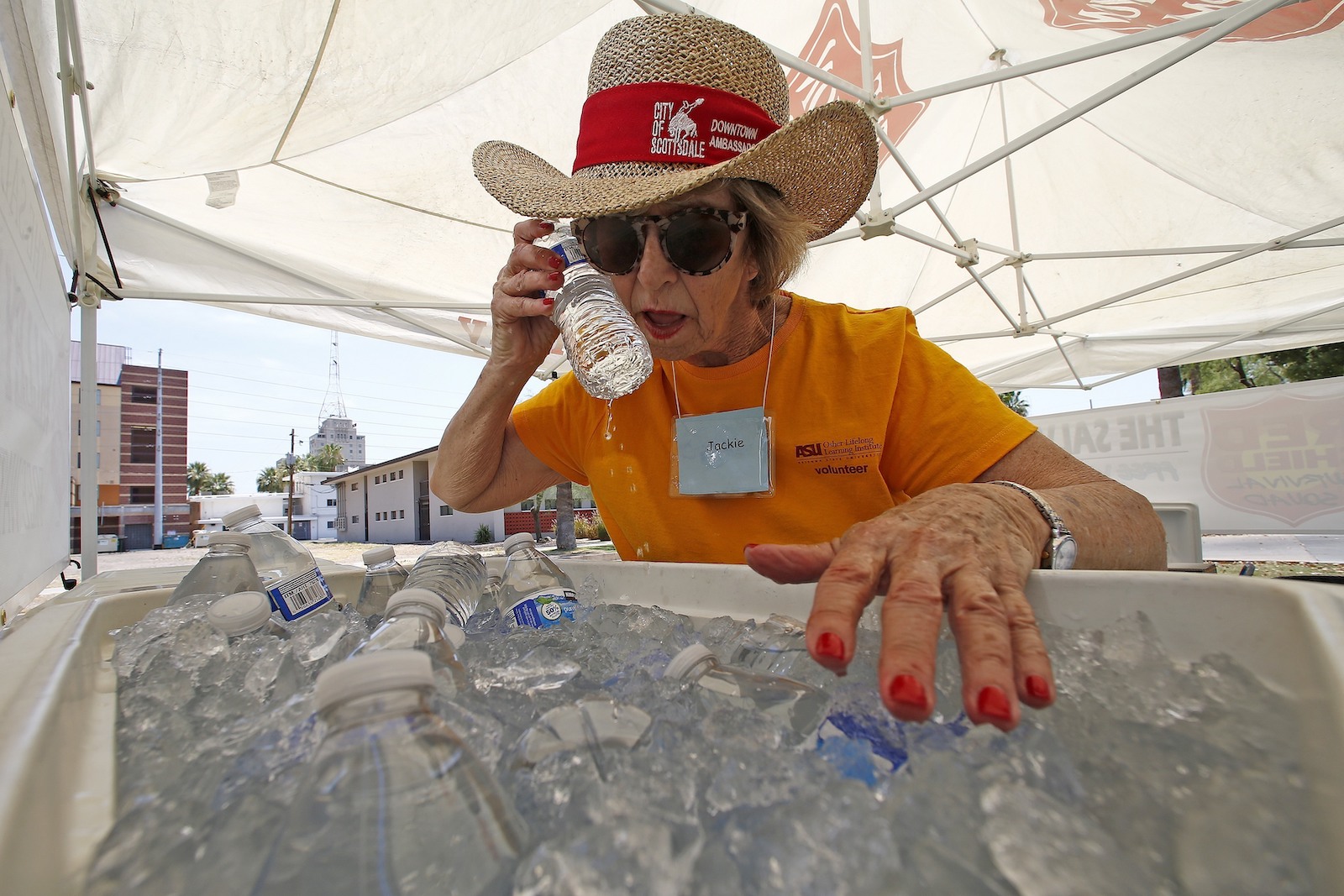
AP / Ross D. Franklin
In the years since the Trump administration took over, the political pressure hampering some of the CDC climate program’s grantees has also been applied to the program itself. Former and current staff said senior agency officials, aware of Trump’s denials of climate science, have tried to keep the program operating under the radar.
Self-censorship surfaced quickly after the 2016 election, even before Trump assumed office. In December of that year, CDC Environmental Health Director Patrick Breysse indefinitely postponed a first-ever climate symposium that was scheduled after the inauguration. George Luber, by then the CDC’s climate chief, remembers his superiors warning the event would be poorly timed; Breysse said the postponement was for budgetary reasons.
The environmental health chief acknowledges that his staff debated whether to use the term “climate change.” He later combined the climate and asthma programs and, internal documents suggest, omitted the word “climate” from the new branch’s title.
Breysse insists the White House never directed his actions. But they served as the basis for a whistleblower complaint filed by Luber, who was removed from his CDC post in 2018. The complaint alleged that Luber was ousted because of his outspokenness on global warming. It stirred a hornet’s nest of public attention, but some program insiders allege his removal had more to do with his mismanagement and mistreatment of employees than his advocacy.
The CDC, which refused to comment on “personnel matters,” said its climate program is running better than ever. The agency pointed to the “mini grants” it has doled out through partner organizations to help another 10 health departments, one-time funding of $5,000 to $50,000.
Meanwhile, every one of Trump’s budget proposals has tried to eliminate the program.
“That somebody would go out of their way to pick off the only $10 million to spend on climate preparedness for health effects is kind of astonishing,” said U.S. Senator Sheldon Whitehouse, a Democrat from Rhode Island, one of the few federal lawmakers to promote the program. He and other congressional Democrats have proposed bills for five of the last 10 years to secure and boost its annual funding. They have not succeeded.
Climate change worsens diseases and disasters — what Whitehouse calls “our ancient mortal enemies.” But, he said, “we haven’t planned for it, and nobody’s really looking at it.”
The inaction in Washington contrasts with some local efforts to save lives endangered by the climate crisis. In Phoenix, spurred on by the sustained surge in heat deaths, some groups hand out 250,000 bottles of water annually to the homeless. Others distribute heat awareness magnets and brochures to the elderly. Still others are developing home sensors that will notify friends and family when indoor temperatures climb.
Selrico Services, which delivers free meals to senior citizens at home, have coordinated with local health workers to survey meal recipients about heat. They train employees to spot and report whether a client’s home is too hot. But Selrico, whose activities are capped by federal funding, delivers meals four days a week to about 1,200 Phoenix residents — less than one percent of the city’s elderly population.
Many vulnerable residents fall through the cracks. Arizona medical examiner records of heat deaths are filled with accounts of aging and isolated people who hadn’t been heard from for days before a wellness check was requested.
Among them were Larry and Kathleen Purchase, 69 and 68 respectively, who died from environmental heat exposure in their Phoenix home during an unusual string of triple-digit days in September 2018. Married for almost 50 years, the two were active in their community and ran a small computer repair service, said Larry’s brother, Terry. When their 1970s rooftop air conditioner broke, they didn’t have the several hundred dollars to fix it.
The day they were found, the temperature in their home hovered around 100 degrees.
Terry remembers the Purchases as “good stewards of the environment,” a tenet of their Christian faith. They didn’t believe in human-caused climate change, he said.
Others at risk are homeless. Just two blocks from Arizona’s state capitol building, in downtown Phoenix, people take refuge under tarps pitched against chain link fences that surround empty lots.
Wendy Johnson runs an area shelter for homeless seniors and has seen firsthand how difficult it can be to protect them from high temperatures. Older adults cannot always tell when their bodies overheat. Homeless seniors, prone to exploitation, often live in cars. “It’s the only safe place they have,” Johnson says. “And they roll the windows up. So they’re baking to death.”
Last summer, she and other shelter employees tried to keep people hydrated with water and electrolytes. But two seniors died from heat just outside the shelter’s doors. One was a migrant worker with no family; the other, a woman with a mental illness who was estranged from her relatives. Because they were withdrawn, Johnson said, she could not tell that they were sick from the heat — heat that will keep intensifying as the world warms.
Dean Russell, Elisabeth Gawthrop, Veronica Penney, Ali Raj and Bridget Hickey are reporting fellows for Columbia Journalism Investigations, an investigative reporting unit at the Columbia Journalism School. Funding for CJI comes from the school’s Investigative Reporting Resource and the Energy Foundation. Additional support for this story was provided by the Fund for Investigative Journalism.
The Center for Public Integrity, a nonprofit investigative news organization, provided editing, fact checking and other support.

